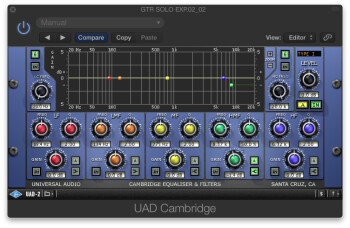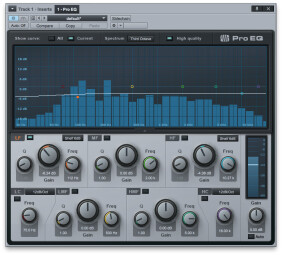Contrary to popular belief, panning and ambience are not the only tools to use for adjusting the location of a track in the sound field of a mix. We are about to see that the sensations of space and depth can be addressed right from the EQing stage.
Depth
In order to understand how EQing can affect the feeling of depth, you first need to analyze your aural perception. What’s the difference, in terms of frequency, between a sound that you hear close to you and one you hear far away? Experiment at home by listening to a simple sound while you move further away from the sound source, and you’ll notice that the sound’s “brightness” is attenuated. In other words, there’s a loss of treble as you move away from the source. Why not use this to your advantage when mixing? After all, you have already spent enough time visualizing your mix to know which instruments ought to be upfront and which ones in the background! Addressing the depth of a mix at this stage will only make things easier when the time comes to bring in the reverbs.
You can successfully move a mix element to the back by applying a shelving filter (found on most EQ plug-ins) in the high frequency range. If you go at it gently, it shouldn’t ruin all the work you’ve done up to now. The rule is relatively simple: The further back you want an instrument to be, the more you attenuate it, and the lower the corner frequency of the shelving band ought to be. Once again, there’s no need for a chain saw. Filtering out –0.5 dB at 10 kHz translates into a good distance already, so imagine what –3 dB at 4 kHz can do!
Before we move on, a brief reminder of the notion of contrast. Don’t forget that white seems more brilliant next to a deep black. Put in audio terms, an instrument will seem more “in your face” if it’s surrounded by elements that are further back.
Width
The feeling of width and depth of sound are intimately related. In fact, the further away a sound is, the harder it is to locate it laterally. From that we can infer that, in order to place a sound precisely on any side of the stereo field, you need to bring it to the front. Consequently, you’ll need to process a signal in the opposite way as described above, namely, with a shelving filter for the high frequencies, but this time you’ll be boosting rather than cutting.
On the other hand, low frequencies are less directional than high frequencies. Hence, an instrument you wish to place to either extreme of the stereo field will be reinforced in its position if you attenuate the lows with a shelving filter.
If you apply these “recipes” consequently with the panning settings you previously made during the rough mix stage, you’ll sense an increased width when listening to the mix in stereo.
Next week, we’ll make our way into the final part of our look at EQ in mixing, with some tips and tricks, as well as a long list of plug-ins that are up to this arduous task.




